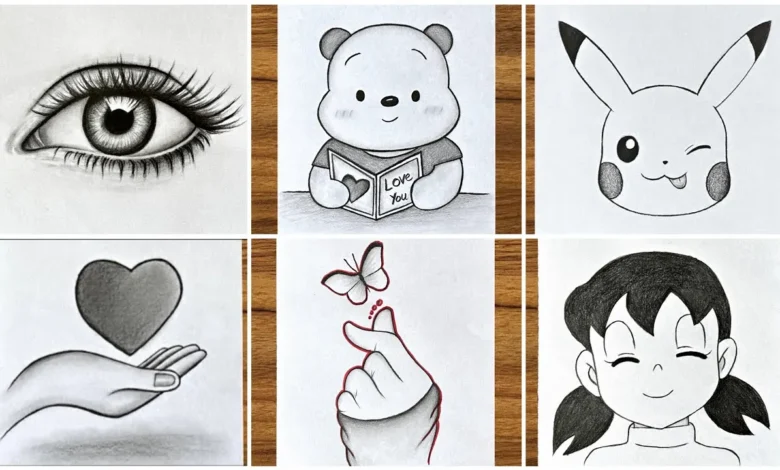Easy Drawings: A Fun and Engaging Guide for Beginners and Artists

Easy Drawings is a fantastic way to express creativity, and it’s also a skill that anyone can develop. Whether you’re a seasoned artist or someone who’s just picked up a pencil for the first time, it can provide a perfect starting point. In this article, we’ll dive into the world of easy drawings, offering tips, inspiration, and step-by-step instructions for beginners and enthusiasts alike. The goal is to make drawing approachable and fun for everyone, so let’s get started on this creative journey!
What Makes Drawings “Easy” and Why Should You Try Them?
When we think about “easy drawings,” we often picture simple shapes and straightforward designs. But the beauty of easy drawings is that they can vary in complexity depending on your skill level. For beginners, easy drawings can mean simple doodles, basic geometric shapes, or even drawing from life with a focus on key features rather than intricate details.
The advantage of easy drawings is that they provide a confidence boost. If you’re new to drawing, starting with easy subjects allows you to gradually build up your skills without feeling overwhelmed. For seasoned artists, easy drawings can be a great way to unwind or warm up before diving into more complex projects. It’s all about enjoyment and improvement.
Tools You Need for Easy Drawings
Before diving into drawing, it’s essential to have the right tools. However, for easy drawings, you don’t need anything too fancy. Here’s a rundown of basic materials that will make your drawing experience more enjoyable:
- Pencils – A simple HB pencil is perfect for most easy drawings. It’s versatile and offers a good balance of light and dark marks.
- Paper – You don’t need professional-grade paper for easy drawings. Regular sketchbooks or printer paper will do the job.
- Erasers – A good eraser is crucial for correcting mistakes, and it also helps create highlights in your drawings.
- Colored Pencils or Markers – If you’re looking to add some color to your easy drawings, a set of colored pencils or markers will bring your creations to life.
- Sharpener – Keeping your pencil sharp will give you more control and precision.
The best part? These tools are easy to find and affordable, making it easy for anyone to start drawing right away.
Simple Shapes and Lines: The Foundation of Easy Drawings
One of the first steps in learning how to draw is understanding basic shapes. These simple forms serve as the foundation for more complex images. By mastering basic shapes, you’ll find that you can easily draw almost anything. Let’s break down the process:
Circles and Ovals
Circles and ovals are versatile shapes that can be used to draw everything from flowers to animals. Start by practicing drawing perfect circles, and then move on to creating ovals. Once you’re comfortable, you’ll begin to notice how these shapes appear in everyday objects like wheels, faces, and even the sun!
Squares and Rectangles
Squares and rectangles are another basic building block of easy drawings. These shapes are great for creating structures, such as houses, books, or even smartphones. By combining squares and rectangles, you can create more intricate drawings with ease.
Triangles and Diamonds
Triangles and diamonds add an extra layer of variety to your drawings. Triangles are excellent for depicting pyramids, mountains, or trees, while diamonds can be used in designs like jewelry or geometric patterns.
Combining Shapes
Once you’re comfortable drawing individual shapes, the next step is to combine them into more complex images. A simple house, for example, can be made by combining a square for the body and a triangle for the roof. Try combining shapes to create animals, trees, or abstract art.
Easy Drawings for Beginners: Step-by-Step Guides
Drawing a Simple Cat
Cats are one of the easiest subjects to draw because they’re made up of simple shapes. Here’s how you can draw a basic cat:
- Draw a circle for the head: This will be the starting point.
- Add two triangular ears: Place the ears at the top of the head, slightly tilted outward.
- Draw an oval body: Under the head, draw a rounded oval to form the cat’s body.
- Sketch the legs: Draw two short, straight lines for the legs, and then add paws at the end.
- Add facial features: Draw two small dots for the eyes, a little triangle for the nose, and a curved line for the mouth.
- Details: Add whiskers, fur details, and a tail to finish.
In just a few steps, you’ve created a cute and simple cat drawing! As you practice, you can refine the details and add more complexity, but this basic approach gives you a solid foundation.
Drawing a Simple Tree
Trees are another excellent subject for easy drawings. Follow these steps to draw a basic tree:
- Draw the trunk: Start with two parallel vertical lines to create the trunk.
- Add branches: Sketch out simple branches extending from the trunk. Keep the lines irregular to make it more natural.
- Draw the leaves: For a simple tree, draw a large oval or cloud-like shape on top of the trunk to represent the foliage.
- Add texture: Add small lines on the trunk to give it a more realistic texture.
- Details: Add shading to the tree to create depth and dimension.
Trees come in many shapes and sizes, so feel free to experiment with different tree types, from tall pines to bushy oaks.
Benefits of Drawing Easy Images Regularly
Drawing is a wonderful hobby that offers numerous benefits, even when focusing on easy drawings. Here are some advantages you can expect from making easy drawings a regular part of your routine:
Improves Fine Motor Skills
Drawing involves the use of your hands and fingers in precise ways, which helps improve fine motor skills. With regular practice, your hand-eye coordination and control over your drawing tools will become more refined.
Boosts Creativity and Imagination
When you start drawing regularly, your imagination begins to flourish. Easy drawings allow you to explore new ideas and experiment with different styles. Whether you’re sketching your favorite animals, plants, or abstract designs, drawing will tap into your creative potential.
Relieves Stress
Drawing is often referred to as a form of mindfulness because it allows you to focus on the present moment. The repetitive motions of sketching can help you relax, reduce stress, and clear your mind.
Builds Confidence
As you see your skills improve, your confidence will grow. Easy drawings provide an excellent way to track your progress and feel accomplished with each new piece. The more you practice, the better you’ll get.
Exploring Easy Drawings with Color
While pencil sketches are beautiful, adding color to your easy drawings can enhance their visual appeal. Whether you choose colored pencils, crayons, or digital tools, coloring allows you to experiment with shades and create a more vibrant image.
Simple Coloring Techniques
- Flat Color: Apply a solid color to each section of your drawing. This is a simple and effective method that adds a clean, polished look to your artwork.
- Gradient Shading: For a more dynamic effect, try blending colors to create smooth transitions. This technique can be especially effective for drawing skies, sunsets, or landscapes.
- Cross-Hatching: This technique involves layering lines in different directions to create texture and depth. It’s a great way to add shading and detail to your drawings.
Adding Details with Color
Once you’ve filled in the basic colors, you can enhance your drawing with more detailed touches. Add highlights to certain areas by using lighter shades, and add shadows with darker hues. These small adjustments will make your drawing stand out and look more polished.
Common Mistakes to Avoid When Drawing
Even when working on easy drawings, it’s important to be mindful of common pitfalls. Here are some mistakes to watch out for:
Overcomplicating the Drawing
When you’re starting, it’s tempting to add too many details or go too far with shading. However, remember that the goal is to keep things simple and fun. Avoid overcrowding your drawings with unnecessary elements.
Forgetting Proportions
Proportions are key to creating realistic drawings, even simple ones. Pay attention to the relative sizes of different elements in your drawing. For example, a cat’s ears should be in proportion to its head, and the tree’s trunk should be wider at the base than at the top.
Rushing the Process
Drawing is a skill that takes time to develop. Avoid rushing through your sketches. Give yourself the time to practice and refine each step, and most importantly, enjoy the process.
Easy Drawings for All Skill Levels
No matter where you are in your artistic journey, there’s always a place for easy drawings. For beginners, these simple subjects can serve as an introduction to the world of art. As you improve, you can tackle more challenging drawings, but remember that easy drawings will always have a place in your artistic repertoire.





